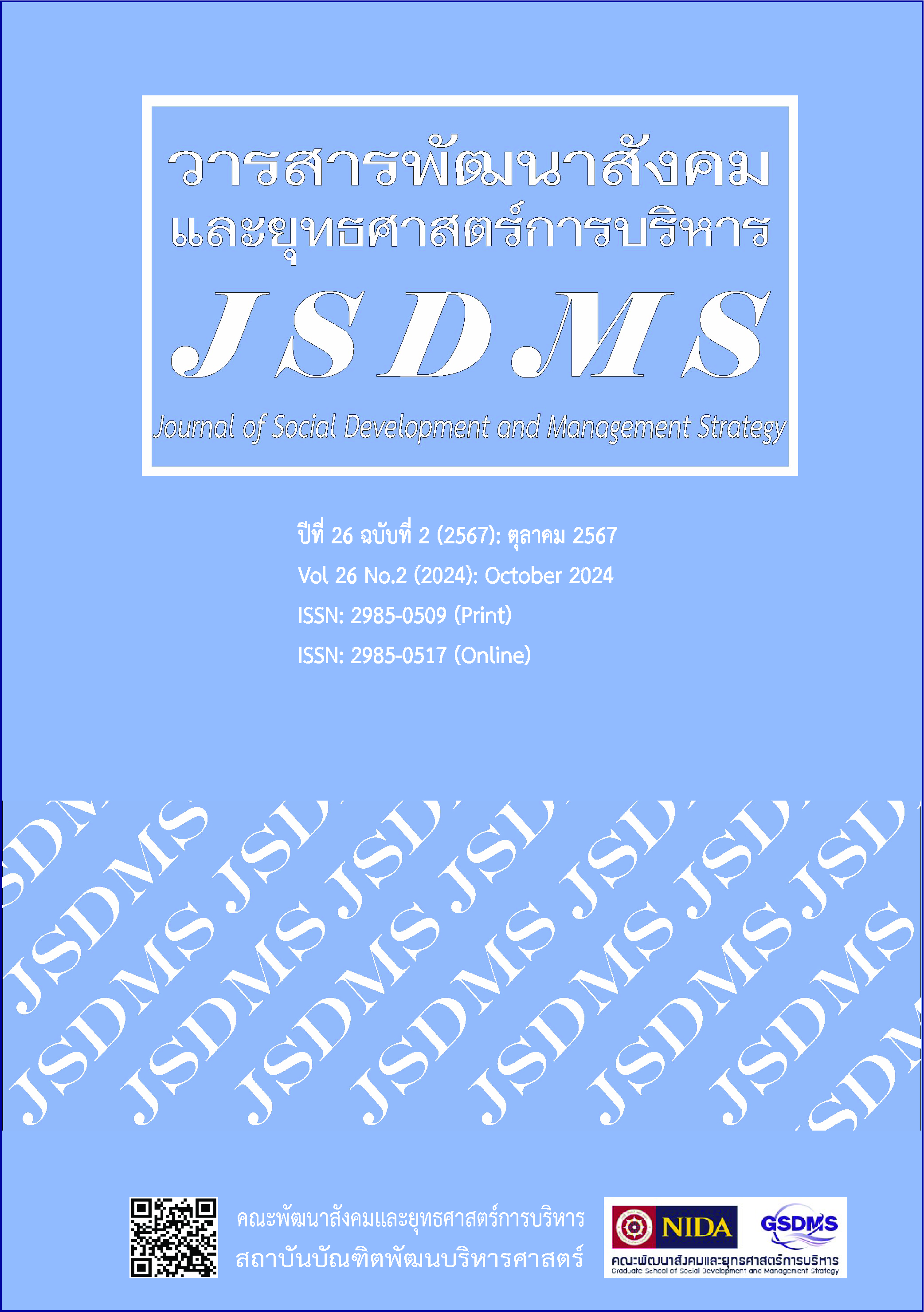The Foundry Industry: Adapting to Sustainability Amidst Digital Era Challenges for Family Businesses in Thailand
Main Article Content
Abstract
The Thai foundry industry, largely comprised of multi-generational family businesses, is facing major changes in the digital era, including intensifying competition, technological advancements, and dynamic industry structures. Entrepreneurs must adapt quickly for survival and sustainable growth. With Thai cast iron product exports valued at 45 billion baht in 2021, the industry's importance to the Thai economy is evident. This article analyzes four key challenges facing Thai family businesses in the foundry industry: technology and innovation, human resource development, environment and energy, and transition to digital business. Based on environmental analysis, the study finds that key strategies for family businesses in this industry should focus on developing knowledge management systems, creating innovation networks, developing corporate brands, planning business succession, adjusting business models, and driving digital transformation. These strategies will help Thai family businesses in the foundry industry adapt and grow sustainably amidst the challenges of the digital era.
Article Details

This work is licensed under a Creative Commons Attribution-NonCommercial-NoDerivatives 4.0 International License.
References
Balmer, J. M. T., & Greyser, S. A. (2003). Revealing the corporation: Perspectives on identity, image, reputation, corporate branding, and corporate-level marketing. London: Routledge.
Chesbrough, H. W. (2003). Open innovation: The new imperative for creating and profiting from technology. Massachusetts: Harvard Business School Press.
Chutira Rabob & Prasertsri Saithong. (2020). Factors for Increasing Competitiveness in Thai Iron Casting Industry. (Unpublished master's thesis) Huachiew Chalermprakiet University, Bangkok. Retrieved from https://has.hcu.ac.th/jspui/handle/123456789/268
Deng, H. (2019). Environmental challenges and opportunities for industrial development: A case study of the automotive and parts industry in Thailand. In T. Sequeira & W. Leal Filho (Eds.), Climate change and the role of education (pp. 513-528). Cham: Springer.
Department of Alternative Energy Development and Efficiency. Ministry of Industry. (2022). National Science, Technology and Innovation Policy and Plan No. 1 (2012-2021). Bangkok: National Science Technology and Innovation Policy Office (STI).
Department of Industrial Promotion. (2020). Metal Casting Industry Development Plan 2020-2024. Bangkok: Office of Industrial Development Committee.
Department of Skill Development. (2020). Labor Situation Report Q3 2020. Bangkok: Office of the Permanent Secretary for Labor.
Dereli, D. D. (2015). Innovation management in global competition and competitive advantage. Procedia - Social and Behavioral Sciences, 195, 1365-1370.
Dessler, G. (2011). Human resource management (12th ed.). Upper Saddle River, New Jersey: Pearson Education.
Digital Economy Promotion Agency. (2021). Digital technology usage survey in the agricultural sector. Bangkok: Aurhor.
Digital Economy Promotion Agency. (2022). E-commerce value survey report in Thailand 2021. Retrieved from https://www.slideshare.net/slideshow/2564-251780796/251780796
Hawawini, G., & Viallet, C. (2010). Finance for executives: Managing for value creation (4th ed.). Massachusetts: South-Western Cengage Learning.
Industry Sector. Ministry of Energy. (2021). Energy conservation plan 2018-2037. Bangkok: Author.
International Automotive Task Force (IATF). (2016). IATF 16949:2016 Quality management system requirements for automotive production and relevant service parts organizations. International Automotive Task Force.
ISO. (2015). ISO 14001:2015 Environmental management systems — Requirements with guidance for use. Geneva: International Organization for Standardization.
ISO. (2015). ISO 9001:2015 Quality management systems — Requirements. Geneva: International Organization for Standardization.
Kaplan, R. S., & Norton, D. P. (1996). The balanced scorecard: Translating strategy into action. Harvard: Harvard Business School Press.
Kitti Korbuakaew. (2010). Production Management. Bangkok: Odeon Store.
KPMG. (2021). The KPMG 2021 EMA Family Business Report. KPMG International.
Liker, J. K. (2004). The Toyota way: 14 management principles from the world's greatest manufacturer. New York: McGraw-Hill.
National Research Council. (2022). Science, Research, and Innovation Index: Ladder to National Development 2022. Retrieved from https://pr.nrct.go.th/wp-content/uploads/2022/11/PDF_November/Handout_R_Index2565.pdf
Nikorn Sukkachat. (2020). Study of problems and support needs in business operations of Thai metal casting industry. Nonthaburi: Rajamangala University of Technology Suvarnabhumi.
Nonaka, I., & Takeuchi, H. (1995). The knowledge-creating company: How Japanese companies create the dynamics of innovation. Oxford: Oxford University Press.
Office of Industrial Economics, Ministry of Industry. (2020). Thai Iron Casting Industry Overview Analysis Report 2020. Bangkok: Office of Industrial Economics.
Office of Natural Resources and Environmental Policy and Planning. (2022). Environmental Quality Management Plan 2023-2027. Bangkok: Ministry of Natural Resources and Environment.
Office of SME Promotion. (2023). SME Situation Report 2023. Retrieved from https://www.sme.go.th/knowledge/รายงานสถานการณ์MSMEรายเดือน
Osterwalder, A., & Pigneur, Y. (2010). Business model generation: A handbook for visionaries, game changers, and challengers. New Jersey: John Wiley & Sons. Inc.
Pollution Control Department. (2020). Thailand's pollution situation report 2019. Bangkok: Ministry of Natural Resources and Environment.
Pollution Control Department. (2021). Annual report 2020 waste and hazardous substances management division. Bangkok: Ministry of Natural Resources and Environment.
Porter, M. E. (1998). Clusters and the new economics of competition. Harvard Business Review, 76(6), 77-90.
PwC. (2021). Global Family business survey 11th Edition: Thailand report. Bangkok: PwC Thailand.
Rothwell, W. J. (2010). Effective succession planning: Ensuring leadership continuity and building talent from within (4th ed.). New York: AMACOM.
Schultz, D. E., & Schultz, H. F. (1998). Transitioning marketing communication into the twenty-first century. Journal of Marketing Communications, 4(1), 9-26.
Thai Automotive Industry Association. (2022). Thai automotive industry trends 2022-2027. Retrieved from https://www.taia.or.th/2022/03/automotive-outlook-2022-2027/
The Federation of Thai Industries. (2021). Economic and business survey results Q4 2021. Retrieved from https://www.depa.or.th/storage/app/media/file/20210118%20publication%20density%20survey%202020.pdf
Westerman, G., Bonnet, D., & McAfee, A. (2014). Leading digital: Turning technology into business transformation. Harvard: Harvard Business Review Press.


